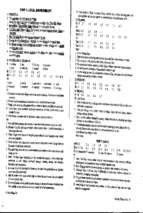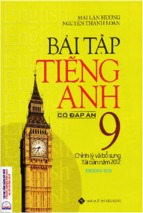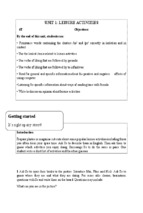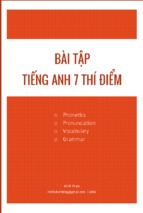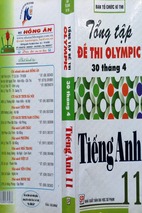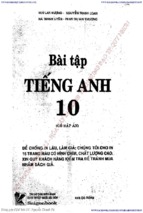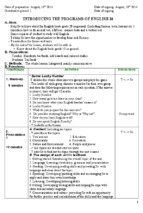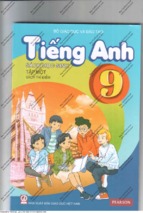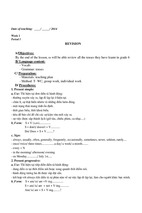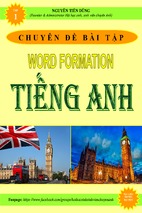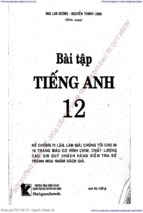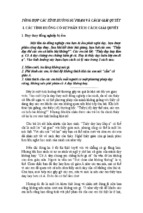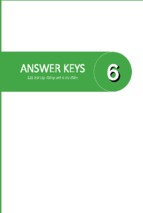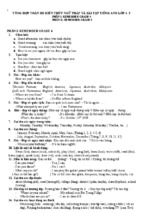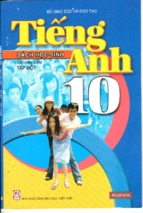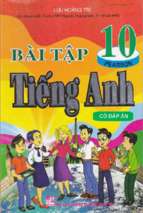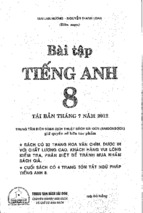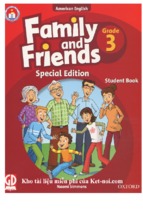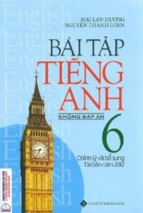For more material and information, please visit Tai Lieu Du Hoc at
www.tailieuduhoc.org
6-10
96 年 10 月 TOFEL 听力 (Page45)
A
1.
(A) He is playing tennis tomorrow.
(B) Someone else has borrowed his racket.
(C) His racket is not usable.
(D) The woman should buy a new tennis racket.
2. (A) The shirt is clean.
(B) The shirt was not expensive.
(C) The man should try to get his money back.
(D) The shirt needs to be washed again.
3. (A) She's willing to help the man.
(B) She's sorry that she injured the man.
(C) She'd like the man to repeat what he said.
(D) She wants to know what happened to the man.
4. (A) He tried to call the woman.
(B) He was too busy to call the woman.
(C) He didn't know he was supposed to call the woman.
(D) He spoke to the woman on the phone last night.
5. (A) She's annoyed by the man.
(B) She'd like a sandwich.
(C) She has already eaten.
(D) She doesn't want anything to eat now.
6. (A) She's not qualified to write the report.
(B) She's too busy to help the man.
(C) She's surprised by the man's request.
(D) She'd rather meet the man tonight.
7. (A) Write a check to pay for the books.
(B) Place an order for more books.
(C) Open the box of books that the company shipped.
(D) Call the company she ordered the books from.
8. (A) She has to type two more pages.
(B) She finished her work long ago.
(C) The man can help her when he's done.
(D) They'll complete their work at about the same time.
9. (A) It predicted the mayor would lose the election.
(B) It clarified the mayor's position.
(C) It didn't accurately represent the mayor's speech.
(D) It listed the mayor's accomplishment.
10. (A) He doesn't have time to go to a movie.
(B) He's upset with the woman.
(C) He doesn't usually enjoy comedies.
(D) He has almost finished his work.
11. (A) The bookstore is rarely crowded.
(B) She's bought all her textbooks for this semester.
(C) Many students have used books to sell.
For more material and information, please visit Tai Lieu Du Hoc at
www.tailieuduhoc.org
(D) Last semester's books cost her several hundred dollars.
12. (A) The graph belongs in the center of the page.
(B) She can't discuss the problem until later.
(C) She's only finished half of the document.
(D) They should look for another graph immediately.
13. (A) He's supposed to go to the meeting.
(B) He wants the woman to give George the message.
(C) He doesn't know why George can't attend the meeting.
(D) He forgot to deliver a message.
14. (A) End his conversation quickly.
(B) Make several calls for the woman.
(C) Take the phone off the hook.
(D) Write down his phone number.
15. (A) Where to meet Sally.
(B) Why Sally wants to meet them.
(C) The location of the park.
(D) The time of the meeting.
16. (A) The woman does not remember her brother's address.
(B) The letters were probably lost in the mail.
(C) The woman will soon get used to college life.
(D) The woman' s brother probably hasn't had time to write.
17. (A) The man ordered his favorite flavor for the woman.
(B) The woman doesn't have a favorite flavor.
(C) The man didn't like the new flavor.
(D) The woman has tasted the new flavor.
18. (A) He started to work in a paint shop.
(B) He hasn't started looking for an apartment.
(C) He had an appointment with a painter today.
(D) He isn't on schedule with his painting.
19. (A) The woman's health has improved.
(B) He does not have enough energy to exercise.
(C) By themselves diets are not useful
(D) Diets can be harmful.
20. (A) His neighbors don't need his help.
(B) His neighbors aren't very sociable.
(C) His neighbors intend to go on vacation.
(D) He's too busy to meet his neighbors.
21. (A) Move the lamp.
(B) Replace the rug.
(C) Pick up one side of the desk.
(D) She'll meet the man at the bank in half an hour.
22. (A) The man should have gone to a different bank.
(B) The man should do business at her bank.
(C) She wouldn't have waited so long.
(D) She'll meet the man at the bank in half an hour.
For more material and information, please visit Tai Lieu Du Hoc at
www.tailieuduhoc.org
23. (A) She is a good cook.
(B) She lives far away from the woman.
(C) She often takes trips abroad.
(D) She often helps people.
24. (A) The station is at the end of the street.
(B) She met an old friend on the subway.
(C) Her friend lives near the subway station.
(D) She's picking someone up at the subway station.
25. (A) Which company the woman will do business with.
(B) Where the woman's business will take place.
(C) Which hotel the woman will stay in.
(D) Where the woman will fly to.
26. (A) She hasn't liked the recent weather.
(B) She's been a little sick.
(C) She's finally gotten over her fever.
(D) She's had a lot of bad luck lately.
27. (A) Borrow the money for the first two months' rent.
(B) Look for a less expensive apartment
(C) Ask his landlord to reassure the owners of the apartment.
(D) Write a letter to the owners of the apartment.
28. (A) The man lost his address book.
(B) The man and the woman already know each other.
(C) The man is sorry to bother Jack Easton.
(D) Jack Easton and the woman work for the same company.
29. (A) The two o'clock train has a dining car.
(B) The two o'clock train will arrive later than the nonstop one.
(C) She plans to eat on the train.
(D) She prefers to take the two o'clock train.
30. (A) The woman is worried about losing some papers.
(B) The woman wants the man to find the report.
(C) The woman saved her report until the last minute.
(D) The woman's report was thrown out by the man.
31. (A) A physics exam.
(B) A lecture they plan to attend
(C) An assignment.
(D) Their favorite poets.
32. (A) When the report is due.
(B) How he chose his topic.
(C) If he passed the course.
(D) Whether her talk is clear.
33. (A) Listen to the woman's talk.
(B) Study for a test.
(C) Go to class.
(D) Prepare his presentation.
34. (A) In the library.
(B) In the woman's dormitory.
For more material and information, please visit Tai Lieu Du Hoc at
www.tailieuduhoc.org
(C) In an empty classroom.
(D) In the dining hall.
35. (A) A professor's lecture.
(B) A magazine article.
(C) A television program.
(D) A doctor's report.
36. (A) Body size and shape.
(B) Influence from the parents
(C) Physical characteristics of the head.
(D) Conditioning from the environment.
37. (A) Different sections of the brain control different body functions.
(B) Blows to certain areas of the skull will affect some brain functions.
(C) Stimulating certain sections of the brain will increase brain functions.
(D) Physical and mental abilities are localized in one section of the brain.
38. (A) The growth of the publishing industry.
(B) The history of papermaking.
(C) The uses of paper in the nineteenth century.
(D) The composition of wood fiber.
39. (A) Publishers wanted higher quality paper.
(B) Paper made from rags deteriorated too quickly
(C) Wood pulp had become too expensive.
(D) The supply of rags was insufficient.
40. (A) It turned out high-quality paper.
(B) It used wood imported from the United States.
(C) It caused a serious deforestation problem.
(D) There was a ready marker for its product.
41. (A) It is difficult to obtain.
(B) Paper cannot be made without it.
(C) It causes paper to deteriorate.
(D) It prevents wood from being turned into pulp.
42. (A) Many of their books are in poor condition.
(B) They have too many books from the early 1800's.
(C) They don't have enough space to store government documents.
(D) They have to import most of the paper they use.
43. (A) Attitudes toward employment.
(B) Attitudes toward leisure activities.
(C) Shifting job opportunities.
(D) The evolution of the weekend.
44. (A) Which days people should work.
(B) How the week is divided into days.
(C) Which day begins the work.
(D) How many weeks there are in a month.
45. (A) The weekend has decreased in length.
(B) The number of national holidays has increased.
(C) People work fewer days per week.
(D) People work more hours each day.
For more material and information, please visit Tai Lieu Du Hoc at
www.tailieuduhoc.org
46. (A) It was six days long.
(B) It didn't include Saturday afternoon.
(C) It always included at least one holiday.
(D) It didn't allow the workers time off.
47. (A) It would make the workday longer.
(B) It would allow people to work on the weekend.
(C) It would make leisure activities expensive.
(D) It would create much more free time.
48. (A) She went to college nearby.
(B) She won a contest.
(C) Her family vacationed there.
(D) She was a friend of Leonard Bernstein's.
49. (A) It's difficult to hear.
(B) The lawn is usually very crowded.
(C) The setting isn't very pretty.
(D) The audience might get wet.
50. (A) It is held in Boston.
(B) All the seats are indoors.
(C) It is not well known.
(D) It has been going on for a long time.
For more material and information, please visit Tai Lieu Du Hoc at
www.tailieuduhoc.org
96 年 10 月 TOFEL 语法(Page46)
B
1. Charlie Parker, _____ was one of the creators of the music style called "bop."
(A) a great jazz improviser who
(B) to improvise great jazz
(C) a great jazz improviser
(D) improvised great jazz.
2. The world's deepest cave, Pierre St. Martin in the Pyrenees Mountains, is almost three times as
deep _____.
(A) as the Empire State Building is high.
(B) That the Empire State Building is higher.
(C) Is higher than the Empire State Building
(D) And the Empire State Building's height.
3. When Columbus reached the New World, corn was the _____ in the Americas.
(A) widely most grown plant.
(B) Most widely grown plant
(C) Most grown widely plant
(D) Plant widely grown most.
4. Because kaolin shrinks in firing at a different rate than ordinary clay, _____ when creating
pottery using both types of clay.
(A) special handling is required
(B) special handling required
(C) a requirement of special handling
(D) the required special handling
5. The ceremonial Chilcat blanket of the Northwest Tlingit Indians was generally _____ from
cedar bark, wool, and goats' hair.
(A) wove
(B) to weave
(C) weaving
(D) woven
6. _____ composed traditionally has been a subject of debate among scholars.
(A) Were ballads how
(B) Ballads were how they
(C) How ballads that were
(D) How ballads were
7. Jupiter, the closest of the giant planets to Earth, has _____ solid surface and is surrounded by
zones of intense radiation.
(A) not
(B) nor
(C) no
(D) neither.
8. The black-billed cuckoo has been known to steal eggs _____ to other birds.
(A) belong
(B) which belonging
(C) which they belong
(D) that belong
For more material and information, please visit Tai Lieu Du Hoc at
www.tailieuduhoc.org
9.The purpose of phonetics is _____ an inventory and a description of the sounds found in speech.
(A) to provide
(B) provided
(C) which provided
(D) providing that
10.
Earthquakes can damage a tree _____ violently, and it can take several years for the tree
to heal.
(A) to cause shaking
(B) when shaking it causes
(C) by causing it to shake
(D) to cause to shake it
11.
_____ bacteria in foods are killed, as they are during baking or stewing, decay is slowed
down.
(A) What
(B) The
(C) If
(D) So
12.
The colors and patterns of the wings of butterflies and moths help _____ the organism
against predators.
(A) protect
(B) being protected
(C) protecting
(D) protection of
13.
(A)
(B)
(C)
(D)
In 1993 the Library of Congress appointed author Rita Dove _____ of the United States.
as was poet laureate
was poet laureate
poet laureate
and poet laureate
14.
(A)
(B)
(C)
(D)
At the South Pole _____, the coldest and most desolate region on Earth.
Antarctica lies where
Where Antarctica lies
Antarctica lies and
Lies Antarctica
15. Tornados, powerful, destructive wind storms, occur most often in the spring when hot winds
_____ over flat land encounter heavy cold air.
(A) which to rise.
(B) that rising
(C) are rising
(D) rising
16. Many exercises such as calisthenics, running, or to swim involve producing
A
B
muscle tension through a range of movements that are called isotonics.
C
D
17. Intelligence, education, and experience all helps shape management style.
A
B
D
C
For more material and information, please visit Tai Lieu Du Hoc at
www.tailieuduhoc.org
18. The basic elements of public-opinion research are interviewers, questionnaires,
A
B
tabulating equipment, and to sample population.
C
D
19. Conservation organizations help for to preserve the ecology of an area by keeping
A
B
C
track of endangered species.
D
20. Gwendolyn Brooks, which won a Pulitzer Prize for Poetry in 1950, had 75 poems published
A
B
C
by the time she was twenty.
D
21. Halifax is largest city and chief port of Nova Scotia and is the eastern terminus of
A
B
Canada's two great railway systems.
C
D
22. T. S. Eliot received wide recognition after publishes The Waste Land, which fused
A
B
poetic traditions with elements of modern music and language.
C
D
23. Numerous types of cells, such as skin cells and white blood cells, have the power reproduce
A
B
C
D
asexually.
24. The knee is more likely to be damage than most other joints because it is subject
A
B
C
to tremendous forces during vigorous activity.
D
25. Although ferns lack flowers, they do have leaves, stems, and root.
A
B
C
D
26. Crazy Horse is generally recognized for his courageous and skill, and he was
A
B
revered by the Sioux as their greatest leader.
C
D
27. In medicine, certain plastics have important uses because they do not affected by
A
B
C
chemicals in the body, and they do not harm the body.
D
28. Since a hospital is organized to protect and treat people who are ill, its goals,
A
structures, and functions depend on the currently state of medical science.
B
C
D
29. A change in direction of the monsoon winds result from the differences between
A
B
the heating or cooling of landmasses and that of oceans.
C
30. Small distinctions among stamps, unimportant to the person average, would mean
A
D
For more material and information, please visit Tai Lieu Du Hoc at
www.tailieuduhoc.org
B
C
a great deal to the stamp collector.
D
31. Members of a nation's foreign service represent that country's interests abroad
A
B
and report on the conditions, trends, and policies of the country which they are
C
D
stationed.
32. Abraham Lincoln's boyhood home resembled those of many others mid-western
A
B
pioneers, with its dirt floor, sleeping loft, and crude fireplace.
C
D
33. Dwelling primarily in the ice northern polar seas, beluga whales are
A
B
C
characteristically small, white, agile, and elusive.
D
34. There is evidence that the caribou originated into North America and crossed over
A
B
C
al land bridge into Asia and evolved into the Old World's reindeer.
D
35. The bold way in which Margaret Mead defined the terms "family" - based as
A
C
much on choice as on biological relationship - is possibly the most enduring of her
B
D
legacies.
36. The planet Mars is a freezing, barren deserts with huge, dry canyons and towering
A
B
C
D
volcanoes.
37. Of the many machines invented in the late nineteenth century, none had a great
A
B
C
impact on the United States economy than the automobile.
D
38. A number of the Pacific Islands are volcanoes that have pushed up from the ocean
A
B
floor, others are the tops sunken mountain ranges.
C
D
39. It has been reported that during any twenty-four hour period, a minimal of three
A
B
hundred North American women start their own businesses.
D
40. Archeological studies have provided evidence that the use of plants for decoration
A
B
C
as well as for food developed early in the history.
B
For more material and information, please visit Tai Lieu Du Hoc at
www.tailieuduhoc.org
D
For more material and information, please visit Tai Lieu Du Hoc at
www.tailieuduhoc.org
96 年 10 月 TOFEL 阅读 (Page47-48)
C
Question 1-8
When Jules Verne wrote Journey to the Center of the Earth in 1864, there were many
conflicting theories about the nature of the Earth's interior. Some geologists thought that it
contained a highly compressed ball of incandescent gas, while others suspected that it consisted of
separate shells, each made of a different material. Today, well over a century later, there is still
little direct evidence of what lies beneath our feet. Most of our knowledge of the Earth's interior
comes not from mines or boreholes, but from the study of seismic waves - powerful pulses of
energy released by earthquakes.
The way that seismic waves travel shows that the Earth's interior is far from uniform. The
continents and the seabed are formed by the crust - a thin sphere of relatively light, solid rock.
Beneath the crust lies the mantle, a very different layer that extends approximately halfway to the
Earth's center. There the rock is the subject of a battle between increasing heat and growing
pressure.
In its high levels, the mantle is relatively cool; at greater depths, high temperatures make the
rock behave more like a liquid than a solid. Deeper still, the pressure is even more intense,
preventing the rock from melting in spite of a higher temperature.
Beyond a depth of around 2,900 kilometers, a great change takes place and the mantle gives
way to the core. Some seismic waves cannot pass through the core and others are bent by it. From
this and other evidence, geologists conclude that the outer core is probably liquid, with a solid
center. It is almost certainly made of iron, mixed with smaller amounts of other elements such as
nickel.
The conditions in the Earth's core make it a far more alien world than space. Its solid iron heart
is subjected to unimaginable pressure and has a temperature of about 9,000oF. Although scientists
can speculate about its nature, neither humans nor machines will ever be able to visit it.
1. The word "conflicting" in line 2 is closest in meaning to
(A) controlling
(B) outdated
(C) opposing
(D) important
2. What is today's richest source of information about the Earth's interior for geologists?
(A) Boreholes
(B) Shells
(C) Seismic waves
(D) Mines
3. The word "There" in line 12 refers to the
(A) mantle
(B) crust
(C) seabed
(D) Earth's center.
4. Which of the following is a primary characteristic of the Earth's mantle?
(A) Light, solid rock
(B) Uniformity of composition
(C) Dramatically increasing pressure
(D) Compressed, incandescent gas
5. The phrase "gives way to" in line 18 is closest in meaning to
(A) runs along
(B) rubs against
For more material and information, please visit Tai Lieu Du Hoc at
www.tailieuduhoc.org
(C) turns into
(D) floats on
6. The word "it" in line 19 refers to
(A) mantle
(B) core
(C) change
(D) depth
7. Why does the author state in line 22 that the Earth's core is "more alien" than space?
(A) Government funds are not available to study the Earth's core.
(B) Scientists aren't interested in the characteristics of the Earth's core.
(C) It is impossible to go to the Earth's core to do research.
(D) The Earth's core is made of elements that are dangerous to humans.
8. The word "speculate" in line 24 is closest in meaning to
(A) report
(B) learn
(C) worry
(D) hypothesize
Question 9-20
Despite the road improvements of the turnpike era (1790-1830). Americans continued as in
colonial times to depend wherever possible on water routes for travel and transportation. The
larger rivers, especially the Mississippi and the Ohio, became increasingly useful as steamboats
grew in number and improved in design.
River boats carried to New Orleans the corn and other crops of northwestern farmers, the cotton
and tobacco of southwestern planters. From New Orleans, ships took the cargoes on to eastern
seaports. Neither the farmers of the west nor the merchants of the east were completely satisfied
with this pattern of trade. Farmers could get better prices for their crops if the alternative existed
of sending them directly eastward to market and merchants could sell larger quantities of their
manufactured goods if these could be transported more directly and more economically to the
west.
New waterways were needed. Sectional jealousies and constitutional scruples stood in the way
of action by the federal government and necessary expenditures were too great for private
enterprise. If extensive canals were to be dug, the job would be up to the various states.
New York was the first to act. It had the natural advantage of a comparatively level route
between the Hudson River and Lake Erie, through the only break in the entire Appalachian
Mountain chain. Yet the engineering tasks were imposing. The distance was more than 350 miles
and there were ridges to cross and a wilderness of woods and swamps to penetrate. The Erie Canal
begun in 1817 and completed in 1825, was by far the greatest construction job that Americans had
ever undertaken. It quickly proved a financial success as well. The prosperity of the Erie
encouraged the state to enlarge its canal system by building several branches.
The range of the New York canal system was still further extended when the states of Ohio and
Indiana, inspired by the success of the Erie Canal, provided water connections between Lake Erie
and the Ohio River.
9. What does the passage suggest was the principal route for transporting crops to the east prior in
1825?
(A) River to road
(B) Canal to river
(C) River to ocean
(D) Road to canal.
10.
It can be inferred from the passage that shipping cargo east by way of New Orleans was
(A) Advantageous for manufactures
For more material and information, please visit Tai Lieu Du Hoc at
www.tailieuduhoc.org
(B) Inexpensive for merchants
(C) Not economical for farmers
(D) Considered economical by the government
11.
The word "alternative" in line 9 is closest in meaning to
(A) option
(B) transition
(C) intention
(D) authorization
12.
(A)
(B)
(C)
(D)
The word "them" in line 9 refers to
crops
farmers
prices
merchants
13.
Which of the following products would a northwestern farmer in the early nineteenth
century be most likely to purchase from the east?
(A) Grain
(B) Vegetables
(C) Textiles
(D) Fruit.
14.
(A)
(B)
(C)
(D)
According to the passage, where was the Erie Canal located?
Between Ohio and Indiana.
Along the Appalachian Mountains
Between Lake Erie and the Ohio River
Across New York State.
15.
(A)
(B)
(C)
(D)
The word "imposing" in line 18 could best be replaced by
impractical
successful
demanding
misleading
16.
(A)
(B)
(C)
(D)
The word "penetrate" in line 20 is closest in meaning to
cut down
go through
fill up
take over
17.
(A)
(B)
(C)
(D)
The word "its" in line 22 refers to
prosperity
Erie
System
State
18.
(A)
(B)
(C)
(D)
The word "extended" in line 24 is closest in meaning to
increased
constructed
deepened
measured
19.
According to the passage, Indiana and Ohio supported the development of the New York
canal system by
(A) helping to build the Erie Canal.
For more material and information, please visit Tai Lieu Du Hoc at
www.tailieuduhoc.org
(B) Building branches to connect it with the Ohio River
(C) Providing much of the water for the Erie Canal.
(D) Contributing financially to the construction costs
20.
(A)
(B)
(C)
(D)
What does the paragraph following the passage probably discuss?
Industry on Lake Erie
Canals in Ohio and Indiana
Sectional jealousies in Indiana and Ohio
Travel on the Erie Canal.
Question 21-31
Legend has it that sometime toward the end of the Civil War (1861-1865) a government train
carrying oxen traveling through the northern plains of eastern Wyoming was caught in a
snowstorm and had to be abandoned. The driver returned the next spring to see what had become
of his cargo. Instead of the skeletons he had expected to find, he saw his oxen, living, fat, and
healthy. How had they survived?
The answer lay in a resource that unknowing Americans lands trampled underfoot in their haste
to cross the "Great American Desert" to reach lands that sometimes proved barren. In the eastern
parts of the United States, the preferred grass for forage was a cultivated plant. It grew well with
enough rain, then when cut and stored it would cure and become nourishing hay for winter feed.
But in the dry grazing lands of the West that familiar bluejoint grass was often killed by drought.
To raise cattle out there seemed risky or even hopeless.
Who could imagine a fairy-tale grass that required no rain and somehow made it possible for
cattle to feed themselves all winter? But the surprising western wild grasses did just that. They
had wonderfully convenient features that made them superior to the cultivated eastern grasses.
Variously known as buffalo grass, grama grass, or mesquite grass, not only were they immune to
drought; but they were actually preserved by the lack of summer and autumn rains. They were not
juicy like the cultivated eastern grasses, but had short, hard stems. And they did not need to be
cured in a barn, but dried right where they grew on the ground. When they dried in this way, they
remained naturally sweet and nourishing through the winter. Cattle left outdoors to fend for
themselves thrived on this hay. And the cattle themselves helped plant the fresh grass year after
year for they trampled the natural seeds firmly into the soil to be watered by the melting snows of
winter and the occasional rains of spring. The dry summer air cured them much as storing in a
barn cured the cultivated grasses.
21.
(A)
(B)
(C)
(D)
What does the passage mainly discuss?
Western migration after the Civil War
The climate of the western United States
The raising of cattle.
A type of wild vegetation
22.
(A)
(B)
(C)
(D)
What can be inferred by the phrase "Legend has it" in line 1?
The story of the train may not be completely factual.
Most history books include the story of the train.
The driver of the train invented the story.
The story of the train is similar to other ones from that time period.
23.
(A)
(B)
(C)
(D)
The word "they" in line 5 refers to
plains
skeletons
oxen
Americans
24.
What can be inferred about the "Great American Desert" mentioned in line 7?
(A) It was not originally assumed to be a fertile area.
For more material and information, please visit Tai Lieu Du Hoc at
www.tailieuduhoc.org
(B) Many had settled there by the 1860's.
(C) It was a popular place to raise cattle before the Civil War.
(D) It was not discovered until the late 1800's.
25.
(A)
(B)
(C)
(D)
The word "barren" in line 8 is closest in meaning to
lonely
dangerous
uncomfortable
infertile.
26.
(A)
(B)
(C)
(D)
The word "preferred" in line 8 is closest in meaning to
ordinary
available
required
favored
27.
Which of the following can be inferred about the cultivated grass mentioned in the
second paragraph?
(A) Cattle raised in the western United States refused to eat it.
(B) It would probably not grow in the western United States.
(C) It had to be imported into the United States.
(D) It was difficult for cattle to digest.
28.
(A)
(B)
(C)
(D)
Which of the following was NOT one of the names given to the Western grasses?
Grama grass
Bluejoint grass
Buffalo grass
Mesquite grass
29. Which of the following was NOT mentioned as a characteristic of western grasses?
(A) They have tough stems.
(B) They are not affected by dry weather.
(C) They can be grown indoors.
(D) They contain little moisture.
30.
(A)
(B)
(C)
(D)
The word "hard" in line 19 is closest in meaning to
firm
severe
difficult
bitter
31.
(A)
(B)
(C)
(D)
According to the passage, the cattle helped promote the growth of the wild grasses by
stepping on and pressing the seeds into the ground
naturally fertilizing the soil
continually moving from one grazing area to another
eating only small quantities of grass.
Question 32-44
Seventeenth-century houses in colonial North America were simple structures that were
primarily functional carrying over traditional designs that went back to the Middle Ages. During
the first half of the eighteenth century, however, houses began to show a new elegance. As wealth
increased, more and more colonists built fine houses.
Since architecture was not yet a specialized profession in the colonies, the design of buildings
was left either to amateur designers or to carpenters who undertook to interpret architectural
manuals imported from England. Inventories of colonial libraries show an astonishing number of
For more material and information, please visit Tai Lieu Du Hoc at
www.tailieuduhoc.org
these handbooks for builders, and the houses erected during the eighteenth century show their
influence. Nevertheless, most domestic architecture of the first three-quarters of the eighteenth
century displays a wide divergence of taste and freedom of application of the rules laid down in
these books.
Increasing wealth and growing sophistication throughout the colonies resulted in houses of
improved design, whether the material was wood, stone, or brick. New England still favored wood,
though brick houses became common in Boston and other towns, where the danger of fire gave an
impetus to the use of more durable material. A few houses in New England were built of stone,
but only in Pennsylvania and adjacent areas was stone widely used in dwellings. An increased use
of brick in houses and outbuildings is noticeable in Virginia and Maryland, but wood remained
that most popular material even in houses built by wealthy landowners. In the Carolinas, even in
closely packed Charleston, wooden houses were much more common than brick houses.
Eighteenth-century houses showed great interior improvements over their predecessors.
Windows were made larger and shutters removed. Large, clear panes replaced the small leaded
glass of the seventeenth century. Doorways were larger and more decorative. Fireplaces became
decorative features of rooms. Walls were made of plaster or wood, sometimes elaborately paneled.
White paint began to take the place of blues, yellows, greens, and lead colors, which had been
popular for walls in the earlier years. After about 1730, advertisements for wallpaper styles in
scenic patterns began to appear in colonial newspapers.
32.
(A)
(B)
(C)
(D)
What does the passage mainly discuss?
The improved design of eighteenth-century colonial houses.
A comparison of eighteenth-century houses and modern houses.
The decorations used in eighteenth-century houses.
The role of carpenters in building eighteenth-century houses.
33. What was one of the main reasons for the change in architectural style in eighteenth-century
North America?
(A) More architects arrived in the colonies.
(B) The colonists developed an interest in classical architecture.
(C) Bricks were more readily available.
(D) The colonists had more money to spend on housing.
34. According to the passage, who was responsible for designing houses in eighteenth-century
North America?
(A) Professional architects
(B) Customers
(C) Interior decorators
(D) Carpenters.
35.
(A)
(B)
(C)
(D)
The passage implies that the rules outlined in architectural manuals were
generally ignored
legally binding
not strictly adhered to
only followed by older builders
36.
(A)
(B)
(C)
(D)
The word "divergence" in line 11 is closest in meaning to
description
development
difference
display
37.
(A)
(B)
(C)
The word "durable" in line 15 is closest in meaning to
attractive
expensive
refined
For more material and information, please visit Tai Lieu Du Hoc at
www.tailieuduhoc.org
(D) long-lasting
38.
(A)
(B)
(C)
(D)
Where was stone commonly used to build houses?
Virginia
Pennsylvania
Boston
Charleston
39.
(A)
(B)
(C)
(D)
The word "dwellings" in line 17 is closest in meaning to
houses
towns
outbuildings
rural areas
40.
(A)
(B)
(C)
(D)
The word "predecessors" in line 23 refers to
colonist who arrived in North America in the seventeenth century.
houses constructed before the eighteenth century
interior improvements
wooden houses in Charleston
41.
(A)
(B)
(C)
(D)
The author mentions elaborately paneled walls in line 26 as an example of
how the interior design of colonial houses was improved.
why walls were made of wood or plaster.
How walls were made stronger in the eighteenth century.
What kind of wood was used for walls after 1730.
42.
(A)
(B)
(C)
(D)
The word "elaborately" in line 26 is closest in meaning to
done in great detail
put together carefully
using many colors
reinforced structurally
43.
(A)
(B)
(C)
(D)
What does the author imply about the use of wallpaper before 1730?
Wallpaper samples appeared in the architectural manuals.
Wallpaper was the same color as the wall paints used
Patterned wallpaper was not widely used.
Wallpaper was not used in stone house.
44. Where in the passage does the author give a reason why brick was the preferred material for
houses in some urban areas?
(A) Lines 9-11
(B) Lines 13-15
(C) Lines 17-19
(D) Lines 23-24
Question 45-50
Bloodhounds are biologically adapted to trailing their prey. The process by which the nose
recognizes an odor is not fully understood, but there are apparently specific receptor sites for
specific odors. In one explanation, recognition occurs when a scent molecule fits into its
corresponding receptor site, like a key into a lock, causing a mechanical or chemical change in the
cell. Bloodhounds apparently have denser concentrations of receptor sites tuned to human scents.
When a bloodhound trails a human being, what does it actually smell? The human body, which
consists of about 60 trillion living cells, sheds exposed skin at a rate of 50 million cells a day. So
even a trail that has been dispersed by breezes may still seem rich to a bloodhound. The body also
produces about 31 to 50 ounces of sweat a day. Neither this fluid nor the shed skin cells have
much odor by themselves, but the bacteria working on both substances is another matter. One
For more material and information, please visit Tai Lieu Du Hoc at
www.tailieuduhoc.org
microbiologist estimates the resident bacteria population of a clean square centimeter of skin on
the human shoulder at "multiples of a million." As they go about their daily business breaking
down lipids, or fatty substances, on the skin, these bacteria release volatile substances that usually
strike the bloodhound's nose as an entire constellation of distinctive scents.
45.
(A)
(B)
(C)
(D)
What does the passage mainly discuss?
Why people choose bloodhounds for household pets
How a bloodhound's sense of smell works
How humans compensate for an underdeveloped sense of smell
The way in which bacteria work on skin cells and body sweat.
46.
(A)
(B)
(C)
(D)
The author compares a scent molecule with a
key
lock
cell
bloodhound
47.
(A)
(B)
(C)
(D)
In line 7, the word "it" refers to
bloodhound
human being
smell
body
48.According to the passage, how many cells of skin does the human body rid itself of every day?
(A) 60 trillion
(B) 50 million
(C) 1 million
(D) Between 31 and 50
49.
(A)
(B)
(C)
(D)
In line 10, the word "rich" is used to mean that a trail is
paved with precious materials
a profitable business to get into
a very costly undertaking
filled with an abundance of clues.
50.
(A)
(B)
(C)
(D)
Which of the following acts as a stimulus in the production of the human scent?
Sweat
Dead skin cells
Bacteria
Fatty substances.
- Xem thêm -

